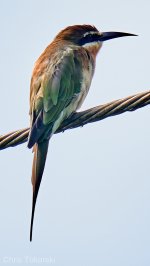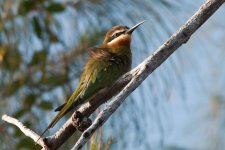-
Welcome to BirdForum, the internet's largest birding community with thousands of members from all over the world. The forums are dedicated to wild birds, birding, binoculars and equipment and all that goes with it.
Please register for an account to take part in the discussions in the forum, post your pictures in the gallery and more.
You are using an out of date browser. It may not display this or other websites correctly.
You should upgrade or use an alternative browser.
You should upgrade or use an alternative browser.
Bee-eater Lake Mburo National Park in June (1 Viewer)
- Thread starter 49bentley
- Start date
More options
Who Replied?
Madagascar (Olive) Bee-eater
Ratal
Well-known member
Check this from Flickr. Oh, and by the way? Great spot and cracking photo you took.Thanks Ratal.
There does seem to be a certain amount of variabiltity in this species. As you say, your bird has a lot more rufous than any pictures I've been able to find online (though I haven't looked much beyond a Google image search).... the extent of rufous down its back had me fooled. I have not been able to find any pics similar to this one. Is this usual?
We saw several birds - at least three and possibly as many as five, based on varying plumage and streamer length - on Lake Baringo in Kenya a couple of years ago. It was December, so presumably these birds are resident and breeding. None had strong rufous outside the throat (i.e. the cap was rufousy in the right light, but nothing very powerful). And nothing like your bird.
Maybe there is strong regional variation. 'Birds of East Africa' 2nd edition says that they are non-breeding winter (April-September) visitors from the south, though 'some may be present year-round'. As I said, these birds were taken in December, so presumably 'year-round'. Maybe northern resident birds are different from more southerly birds, and Kenyan birds from Ugandan birds?
I haven't been able to find any photo looking like the bright blue bird in my photos. I assumed it was a juvenile beginning to moult into adult plumage, though it looks nothing like the immature illustrated in 'Birds of East Africa'. I haven't been able to find any birds looking like this online either.
If Ratal or Andre have any comment on this bird, I'd be interested and grateful.
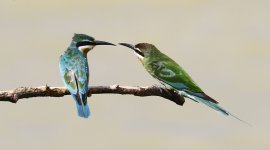
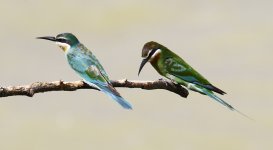
Last edited:
Hi 49Bentley. I just checked your uploaded photo, and you have left the title as just the photo number that the camera allocated it which is cat03293-d-jpg.Thanks Ratal. Niels I uploaded the pic to the gallery.
I'm not sure if you can edit titles in the Gallery, but if you can I think it would be nice to give it a title such as 'Madagascar Bee-eater (Uganda, June)' or something helpful like that. (Not a criticism, just a comment).
By the way, I found this gallery online from Tanzania, and bird 8 in the slideshow has a bird with the brown crown going well down the back like your bird.
Hi Neils, I am happy to upload a few photos. I think the limit is still three per day, but I have four or five different ones so I will spread them out.I can find one previous image in the birdforum gallery, some (or all) of these photos would be very welcome!
Niels
QUESTION: In the past when I have occasionally uploaded three photos of the same species, taken in the same place, with the same equipment, I found it annoying to have to input all this information for all three photos separately. Is there some way that you can automatically input the same data for three photos without having to repeat it (and then just add a slightly different comment)?
Hi Ratal, I'd just like to clarify this ID a bit more with your help (and anyone else who is looking).Yours is an eastern variant Olive Bee Eater juvenile and adult.
Remember, this bird will be less than 19 days old. After that? On their own.
I tried to find a bird online that looks like the young bird but couldn't. Indeed there don't seem to be many photos of this species at all. The only photos of non-adult birds I could find were the attached pair from a site called 'Tanzanian Birds and Butterflies' It says the left bird is a 'juvenile' and the right is an 'immature'. (I hope this is 'fair use' I've given the link also; if people think it isn't, I'll remove it.)
You say this is a pre-fledging bird (less than nineteen days), so 'immature' I guess (people seem to use 'juvenile' and 'immature' differently).
There are two points about my bird that I am interested in.
The main thing is how blue the bird is. Does this mean that young birds start out bright blue? On the other hand the adult has significant blue also on the wings and tail, but not the back. Is this a regional thing, or just a purely individual thing?
The other thing is that the bird shows a clear well-developed white supercilium and cheek-patch, whereas 'Birds of East Africa' shows the immature with these indistinct and not white, and without all these blue tones.
(Also, there's no sign of a gape-line. Should there be? I didn't see the adult feeding it, either; they were just there on the same branch hanging over the lake, outside our room.)
What I'm saying, I suppose, is whether it is possible that the left bird in my two-bird photos is actually an adult (female?) going through a regular moult where the feathers start out bluer than they become.
'Birds of East Africa', and also 'Birds of Kenya' by Zimmerman et al, say they sometimes breed in coastal Kenya, but since these photos are taken at Lake Baringo (Tumbili Cliffs Lodge) in the far west of Kenya, I suppose this shows that they breed there, too (assuming the blue bird is a juvenile).
Looking at my photos, judging from streamer length and shape, there were at least three adults as well as the young-presumed bird, but I think there were at least a couple more.
(There were also Blue-cheeked Bee-eaters and White-throated Bee-eaters there.)
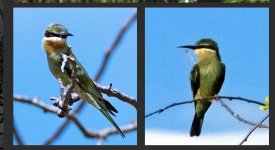
Last edited:
I edited the previous post, and I add the edit here just to see if anyone has an opinion.
Because otherwise I can't see any juvenile features. And can't find anything online to say one way or the other.
What I'm saying, I suppose, is whether it is possible that the left bird in my two-bird photos is actually an adult (female?) going through a regular moult where the feathers start out bluer than they become.
Because otherwise I can't see any juvenile features. And can't find anything online to say one way or the other.

I am not aware of a way to do what you describe unless the browser sees it as a form and gives you an option to reuse a previous answer.Hi Neils, I am happy to upload a few photos. I think the limit is still three per day, but I have four or five different ones so I will spread them out.
QUESTION: In the past when I have occasionally uploaded three photos of the same species, taken in the same place, with the same equipment, I found it annoying to have to input all this information for all three photos separately. Is there some way that you can automatically input the same data for three photos without having to repeat it (and then just add a slightly different comment)?
Niels
As can be seen in my post above #15, I was unsure of the status of the blue-ish bird in my photos in post #7.
I noticed that our member Tib78 has recently started posting again after an absence. Regular BF visitors with an interest in African birds will be aware of his expertise. So I took the liberty of asking him for his comments on this bird.
I summarise his comments here, with his permission, since I think they may be of interest to others as well as myself.
Juvenile Olive/Madagascar Bee-eater basically looks like the immature illustrated in plate 116 of 'Birds of East Africa' though the cheek patch may be more extensive and prominent than it seems in this illustration, meaning that the immature may with a clear view be distinguished in the field from the otherwise fairly similar Blue-cheeked immature.
As the juvenile bird progresses through life, the green colouration becomes abraded and reveals a blue underlying colouration. By the time the juvenile is ready to moult to adult plumage it appears mainly blue on the back. (This is also the case with Blue-cheeked immature.)
So, my bird is a juvenile moulting into adult plumage - the blue colouration being the remaining juvenile plumage and the green the emerging adult plumage.
The bird is not, as was suggested, less that nineteen days old (i.e. not fully fledged) but several months old (how many is not clear).
I suggested that the presence of this juvenile bird at Lake Baringo might be evidence of breeding inland, whereas the book suggests that there is only occasional breeding in Kenya near the coast. However, since this juvenile is several months old, it doesn't provide evidence of breeding near this location, since it may have been born quite far away and merely flown here after fledging, with parents and other birds. The movements of this species are not clear, but it is certain that they move around quite a lot in the non-breeding season.
I noticed that our member Tib78 has recently started posting again after an absence. Regular BF visitors with an interest in African birds will be aware of his expertise. So I took the liberty of asking him for his comments on this bird.
I summarise his comments here, with his permission, since I think they may be of interest to others as well as myself.
Juvenile Olive/Madagascar Bee-eater basically looks like the immature illustrated in plate 116 of 'Birds of East Africa' though the cheek patch may be more extensive and prominent than it seems in this illustration, meaning that the immature may with a clear view be distinguished in the field from the otherwise fairly similar Blue-cheeked immature.
As the juvenile bird progresses through life, the green colouration becomes abraded and reveals a blue underlying colouration. By the time the juvenile is ready to moult to adult plumage it appears mainly blue on the back. (This is also the case with Blue-cheeked immature.)
So, my bird is a juvenile moulting into adult plumage - the blue colouration being the remaining juvenile plumage and the green the emerging adult plumage.
The bird is not, as was suggested, less that nineteen days old (i.e. not fully fledged) but several months old (how many is not clear).
I suggested that the presence of this juvenile bird at Lake Baringo might be evidence of breeding inland, whereas the book suggests that there is only occasional breeding in Kenya near the coast. However, since this juvenile is several months old, it doesn't provide evidence of breeding near this location, since it may have been born quite far away and merely flown here after fledging, with parents and other birds. The movements of this species are not clear, but it is certain that they move around quite a lot in the non-breeding season.
Users who are viewing this thread
Total: 2 (members: 0, guests: 2)





